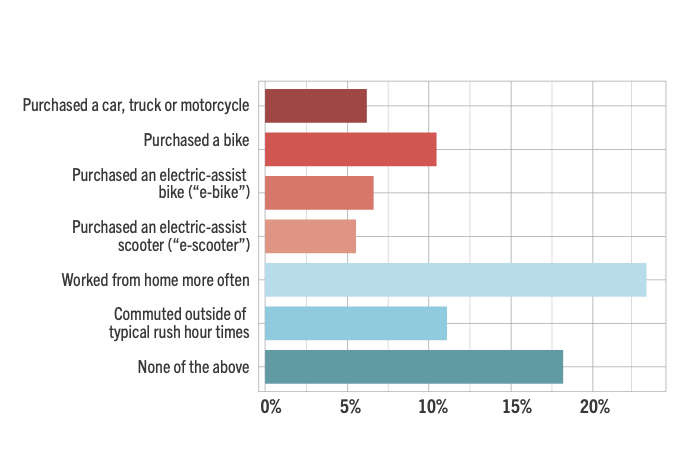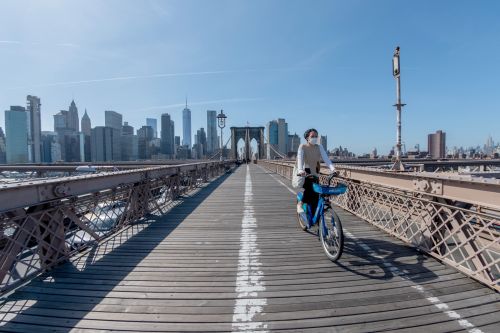A version of this article appeared in the August issue of BRAIN.
SAN FRANCISCO (BRAIN) — The 2020 bike boom is expanding into the micromobility sector with share-bike and share-scooter interest and ridership growing after cities reopened following COVID-19 restrictions. Many in the industry who BRAIN contacted said ridership is up, backing mobility giant Lime's extensive mid-June report measuring transportation preferences in five cities around the world: New York, Seattle, Berlin, London, and Seoul.
The Lime survey comes as city leaders grow concerned about residents' short- and long-term transportation system behavioral changes. If ride-share users forego public transportation because of COVID-19 concerns, will they resort to cars or try bikes or shared scooters?
The public survey was executed between May 26 and June 17 and among other micromobility trends showed: 68% of respondents said they would use share-scooters in the future — an increase of 25 percentage points compared to before COVID-19. This suggests that two out of three people intend to use scooters as a transportation solution. In cities without existing scooter-share programs (Seattle, New York, and London), 75% said they intend to ride scooters in the future. In fact, one out of three respondents (35%) said they will use it weekly or daily, implying it will likely become a regular commuting habit. Twenty-three percent reported purchasing a bike, e-bike, or e-scooter as a result of the COVID-19 pandemic, while 6% purchased a car, truck, or motorcycle. Ride-hailing usage declined with 48% saying they used it during the COVID-19 crisis compared to 71% who used it before — a 23 percentage point reduction. However, respondents plan to return to pre-pandemic levels for future use, suggesting that the window is closing for cities to encourage a shift toward sustainable modes like walking, micromobility, and public transit.
The study concludes that bikes and scooters are a convenient, affordable, and safe way to travel and can be the ideal transportation during this uncertain time and in the future.
"I think there's no question that people are showing a renewed interest in bicycling and are open to using bike-share and scooter-share for work or other trips," said Ken McLeod, policy director for The League of American Bicyclists. While Lime's survey emphasized share-scooter usage, respondents in New York City, Seattle and London were asked about bike-share use, said Calvin Thigpen, Lime's director of policy and the survey's author and researcher.
"We learned that prior to COVID-19, about one in 10 respondents used bike share on a weekly basis for recreation, social outings, or errands," he said. "It's clear that micromobility can play an important car-free role for residents' transportation needs."
Bike share can lead to bike ownership
And exposure to bike-sharing services often leads to bike ownership, said Brianne Eby, senior policy analyst for the Eno Center for Transportation.
"It is reasonable to think that those who own bikes — and are thus comfortable with bicycling as a mode of transportation — would still have reason to use bike-share from time to time," said Eby, who manages and conducts research on transportation policies.
"For example, I personally own a bike, but there are days when, rather than using it, I commute to work using transit due to weather but ride bike-share to get home."
On the subject of commuting, that's another area where trends are shifting. "Many bike-share operators tell me that their ridership has approached or surpassed their highest levels ever over the past few months," said Zoe Kircos, PeopleForBikes' director of grants and partnerships. "The patterns have shifted in ways you expect: fewer rides that look like commutes — morning rides to downtown areas, evening rides back out — and more rides that look recreational — along trails and in neighborhoods, mid-day, longer."
Kircos, who works to expand access to bike-share, said plenty of factors contribute to this shift, "including weather, low- or no-cost pass options made available in the spring for essential workers or sometimes everybody, e-bike additions to fleets, docks placed in high-use areas like grocery stores and health facilities. The systems that I've heard have decreased use are those in university towns that depend on students for a lot of rides. Again, not surprising."
Access given to essential workers has boosted Lyft's bike and scooter ridership, said Caroline Samponaro, Lyft's head of transit and micromobility policy. She noted an increase in new riders, more recreational usage, and longer trip distances.
Record female ridership in New York City
"In New York City, [Lyft-operated] Citi Bike has seen record female ridership, as more than 60% of critical workers are female," said Samponaro, who noted the company is at an all-time high in members in part because of the free Critical Workforce program.
"Overall, Lyft's Critical Workforce Program has brought over 350,000 free trips to critical workers across the country to date. It's more important now than ever that we design our streets for people choosing bikes and avoid prioritizing private cars. As everyone is rethinking the ways they travel and move about cities, bike-share systems are a safe and highly resilient form of urban transportation."
Improved micromobility infrastructure — the creation of more "slow streets" — is key to making the boom more than a blip, said Thigpen, who cited studies by professors Kay Teschke and Wesley Marshall.
New York City, in addition to Berlin and London, created temporary slow streets during the pandemic to enhance micromobility access. "Academic research shows the substantial safety benefits of allocating space to micromobility, whether it's in the form of protected bike lanes/cycletracks on busy streets or in designated routes on local streets," Thigpen said. "A key piece of professor Teschke's research is that bicyclists and scooter riders perceive and benefit from the safety improvements provided by good infrastructure — they don't feel comfortable on high-speed, high-volume streets without protection from cars. So, if we want to keep people on scooters and bikes and out of cars during this pandemic, making these temporary slow streets permanent is going to be an important step.
"Encouragingly, our survey report shows there is strong support for making some or all slow streets permanent — over 80% — so city leaders should feel confident making that choice for their citizens."
Eby agreed but also added, "To that end, [slow streets] may increase bike-share ridership, but other factors like physical ability, affordability, weather, geography, and openness to using a service that is shared may also factor into bike-share ridership."
It's up to elected officials
Industry veteran Ben Serotta, a bike-share consultant, said increasing micromobility options in crowded cities depends on the willingness of elected officials to make it a priority.
"My greatest hope is that these times will embolden elected and appointed officials — driven by taxpayer demand — to commit to lasting long-term changes on a broad scale," said Serotta, who relaunched his bike brand earlier this year.
"Share systems thrive when availability is widespread, dense, and always accessible. You can't make riding or scooting your one way of getting somewhere unless you know it is available when and where you need it, when equipment is reliable, practical and pleasant to use, and it is safe. Safe to use because the equipment itself is designed and maintained with safety in mind, that the road/path/lane used is actually safe from large vehicles and that other inhabitants of these lanes of traffic are not proceeding like self-indulgent idiots and these safer roads need to be everywhere, not here and there. All these aspects must be predictably available."
In addition, share companies implementing anti-bacterial cleaning methods for bikes and scooters will be critical to ensuring a viable transportation alternative.
"Operators should commit to robust cleaning protocols and communicate these protocols to riders," Eby said.
Equipment safety also needs to extend mechanically, Serotta said. "We've been in the wild, wild west, a free-for-all experiment in equipment and systems while municipalities have been too slow to grapple with the risks and greater opportunities of a greener, faster, healthier way of moving people and products around. And last, some of the savings will need to support the cost of the equipment itself. Share rides have been provided at bargain rates. Why is the fastest way of getting around also the cheapest? It doesn't need to be the cheapest; it needs to be affordable for everyone, and it has to be great. Both are possible."


